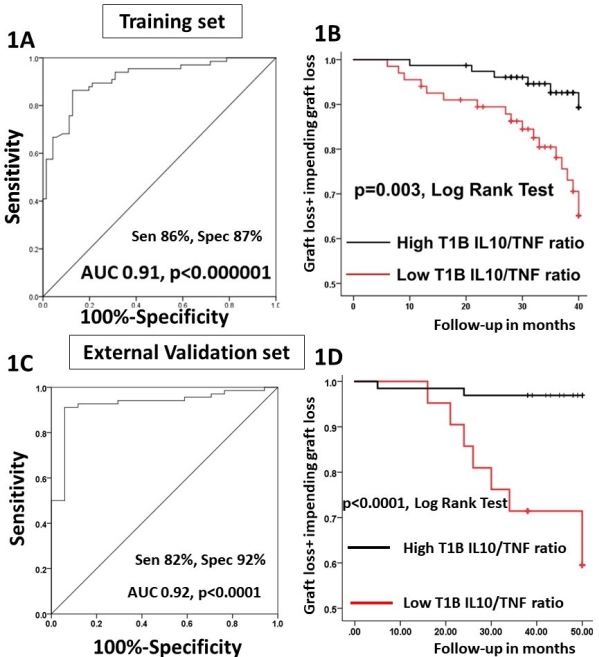Prospective Multicenter Validation of Human Transitional B Cell Cytokines as a Predictive Biomarker in Renal Transplantation
1UPMC, Pittsburgh
2UCL, London, United Kingdom.
Meeting: 2018 American Transplant Congress
Abstract number: 495
Session Information
Session Name: Concurrent Session: Biomarkers, Immune Monitoring and Outcomes: Clinical
Session Type: Concurrent Session
Date: Tuesday, June 5, 2018
Session Time: 4:30pm-6:00pm
 Presentation Time: 4:42pm-4:54pm
Presentation Time: 4:42pm-4:54pm
Location: Room 602/603/604
In renal transplantation, non-invasive biomarkers are needed to identify patients at risk for poor outcomes and guide pre-emptive therapy. Here, we assessed B cell cytokines as a predictive biomarker.
165 patients with serial Bxs (3&12mo protocol+for-cause) and blood draws served as the training set. IS was Thymo→MPA+TAC. Based on prior data, we tested the ratio of IL10:TNFα expression (Cpg+CD40L, by FACs) in peripheral blood T1 transitional B cells (T1B) 3mo post-transplant, as a biomarker. A low T1B IL10:TNFα ratio at 3mo predicted acute rejection (AR) within the 1st yr (Fig1A). Notably, in patients with a normal Bx at 3mo, a low T1B cytokine ratio strongly predicted late AR (6-12mo;AUC 0.9, p<0.0001). These data were validated in an independent internal cohort (n=74). Further, a low T1B cytokine ratio was associated with IFTA (12 mo) and graft loss/impending graft loss (eGFR<30ml/min & >30% fall from baseline) at 4yrs (Fig1B). The predictive value of this biomarker was not influenced by opportunistic infection or by non-adherence.
Next, T1B cytokine ratio was validated in an external UK cohort (n=100). IS was Simulect→TAC+MMF). All AR in this group was clinical (no protocol Bxs). Again, the T1B cytokine ratio at 3mo strongly predicted AR within the 1st yr (Fig1C), and was associated with poor graft outcomes (Fig1D).
B cells in high-risk patients express excessive TNFα relative to IL10. Culture of B cells from such patients with α-TNF, reduced TNFα and increased their IL10 expression. Such B cells subsequently suppressed autologous T cell TNFα while increasing IL10 expression. Thus, α-TNF restored a normal B cell cytokine balance (Breg activity) in high-risk patients. Finally, α-TNF inhibited in vitro differentiation of B cells to plasma cells, reduced their Ab secretion and increased their IL-10 expression.
Thus, T1B IL10:TNFα ratio (3mo) was tested and validated as a strong biomarker for subsequent renal allograft rejection and clinical course. Importantly, our data not only identifies patients in need of pre-emptive therapy, but provides rationale for therapeutic intervention based on TNF blockade.
CITATION INFORMATION: Cherukuri A., Chittka D., Sharma A., Salama A., Magee C., Rothstein D. Prospective Multicenter Validation of Human Transitional B Cell Cytokines as a Predictive Biomarker in Renal Transplantation Am J Transplant. 2017;17 (suppl 3).
To cite this abstract in AMA style:
Cherukuri A, Chittka D, Sharma A, Salama A, Magee C, Rothstein D. Prospective Multicenter Validation of Human Transitional B Cell Cytokines as a Predictive Biomarker in Renal Transplantation [abstract]. https://atcmeetingabstracts.com/abstract/prospective-multicenter-validation-of-human-transitional-b-cell-cytokines-as-a-predictive-biomarker-in-renal-transplantation/. Accessed December 25, 2025.« Back to 2018 American Transplant Congress
